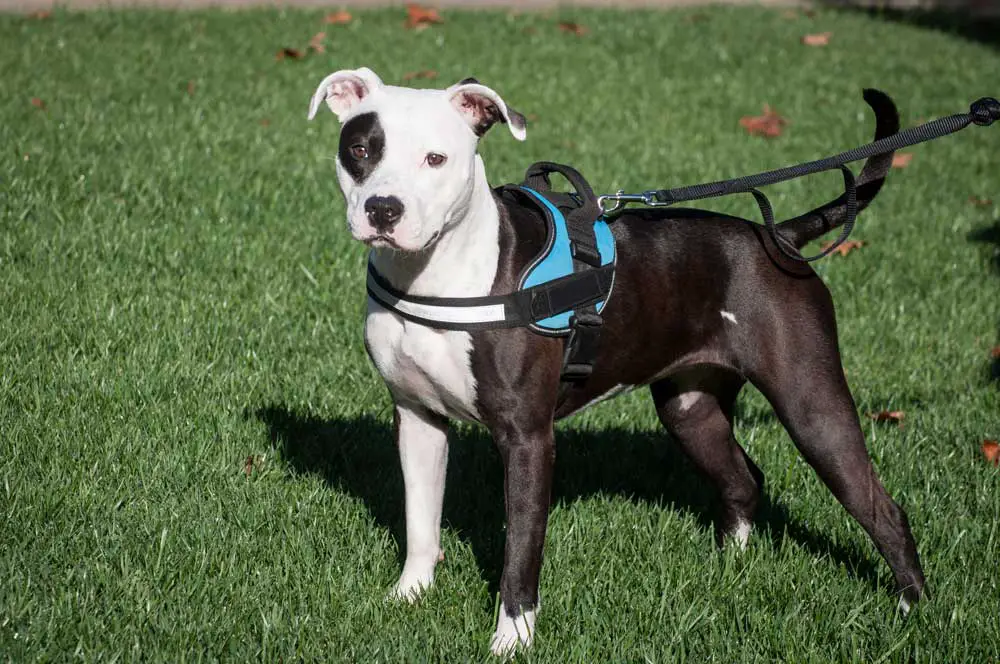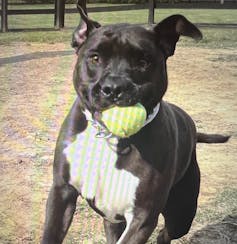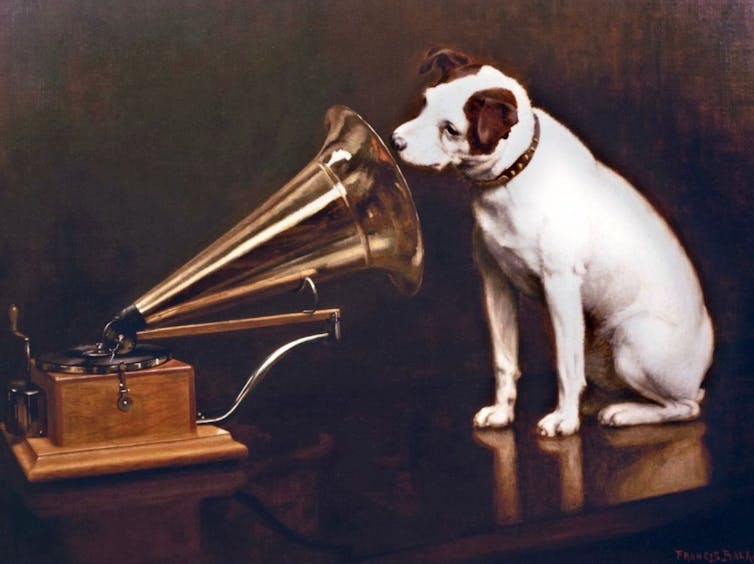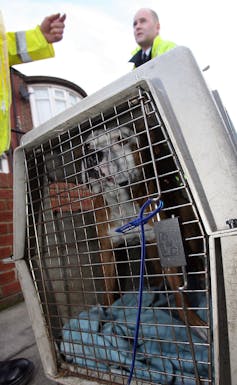
By Colin Dayan
As recently as 50 years ago, the pit bull was America’s favorite dog. Pit bulls were everywhere. They were popular in advertising and used to promote the joys of pet-and-human friendship. Nipper on the RCA Victor label, Pete the Pup in the “Our Gang” comedy short films, and the flag-wrapped dog on a classic World War I poster all were pit bulls.
With National Pit Bull Awareness Day celebrated on Oct. 26, it’s a fitting time to ask how these dogs came to be seen as a dangerous threat.
Starting around 1990, multiple features of American life converged to inspire widespread bans that made pit bulls outlaws, called “four-legged guns” or “lethal weapons.” The drivers included some dog attacks, excessive parental caution, fearful insurance companies and a tie to the sport of dog fighting.
As a professor of humanities and law, I have studied the legal history of slaves, vagrants, criminals, terror suspects and others deemed threats to civilized society. For my books “The Law is a White Dog” and “With Dogs at the Edge of Life,” I explored human-dog relationships and how laws and regulations can deny equal protection to entire classes of beings.

Colin Dayan, CC BY-ND
In my experience with these dogs – including nearly 12 years living with Stella, the daughter of champion fighting dogs – I have learned that pit bulls are not inherently dangerous. Like other dogs, they can become dangerous in certain situations, and at the hands of certain owners. But in my view, there is no defensible rationale for condemning not only all pit bulls, but any dog with a single pit bull gene, as some laws do.
I see such action as canine profiling, which recalls another legal fiction: the taint or stain of blood that ordained human degradation and race hatred in the United States.

Wikipedia
Bred to fight
The pit bull is strong. Its jaw grip is almost impossible to break. Bred over centuries to bite and hold large animals like bears and bulls around the face and head, it’s known as a “game dog.” Its bravery and strength won’t allow it to give up, no matter how long the struggle. It loves with the same strength; its loyalty remains the stuff of legend.
For decades pit bulls’ tenacity encouraged the sport of dogfighting, with the dogs “pitted” against each other. Fights often went to the death, and winning animals earned huge sums for those who bet on them.
But betting on dogs is not a high-class sport. Dogs are not horses; they cost little to acquire and maintain. Pit bulls easily and quickly became associated with the poor, and especially with Black men, in a narrative that connected pit bulls with gang violence and crime.
That’s how prejudice works: The one-on-one lamination of the pit bull onto the African American male reduced people to their accessories.

Owen Humphreys – PA Images via Getty Images
Dogfighting was outlawed in all 50 states by 1976, although illegal businesses persisted. Coverage of the practice spawned broad assertions about the dogs that did the fighting. As breed bans proliferated, legal rulings proclaimed these dogs “dangerous to the safety or health of the community” and judged that “public interests demand that the worthless shall be exterminated.”
In 1987 Sports Illustrated put a pit bull, teeth bared, on its cover, with the headline “Beware of this Dog,” which it characterized as born with “a will to kill.” Time magazine published “Time Bombs on Legs” featuring this “vicious hound of the Baskervilles” that “seized small children like rag dolls and mauled them to death in a frenzy of bloodletting.”
Presumed vicious
If a dog has “vicious propensities,” the owner is assumed to share in this projected violence, both legally and generally in public perception. And once deemed “contraband,” both property and people are at risk.
This was evident in the much-publicized 2007 indictment of Atlanta Falcons quarterback Michael Vick for running a dogfighting business called Bad Newz Kennels in Virginia. Even the Humane Society of the United States and People for the Ethical Treatment of Animals – two of the nation’s leading animal welfare advocacy groups – argued that the 47 pit bulls recovered from the facility should be killed because they posed a threat to people and other animals.
If not for the intervention of Best Friends Animal Society, Vick’s dogs would have been euthanized. As the film “Champions” recounts, a court-appointed special master determined each dog’s fate. Ultimately, nearly all of the dogs were successfully placed in sanctuaries or adoptive homes.
Debating breed bans
Pit bulls still suffer more than any other dogs from the fact that they are a type of dog, not a distinct breed. Once recognized by the American Kennel Club as an American Staffordshire terrier, popularly known as an Amstaff, and registered with the United Kennel Club and the American Dog Breeders Association as an American pit bull terrier, now any dog characterized as a “pit bull type” can be considered an outlaw in many communities.
For example, in its 2012 Tracey v. Solesky ruling, the Maryland Court of Appeals modified the state’s common law in cases involving dog injuries. Any dog containing pit bull genes was “inherently dangerous” as a matter of law.
This subjected owners and landlords to what the courts call “strict liability.” As the court declared: “When an attack involves pit bulls, it is no longer necessary to prove that the particular pit bull or pit bulls are dangerous.”
Dissenting from the ruling, Judge Clayton Greene recognized the absurdity of the majority opinion’s “unworkable rule”: “How much ‘pit bull,’” he asked, “must there be in a dog to bring it within the strict liability edict?”
It’s equally unanswerable how to tell when a dog is a pit bull mix. From the shape of its head? Its stance? The way it looks at you?
Conundrums like these call into question statistics that show pit bulls to be more dangerous than other breeds. These figures vary a great deal depending on their sources.
Any statistics about pit bull attacks depend on the definition of a pit bull – yet it’s really hard to get good dog bite data that accurately IDs the breed.
Over the past decade, awareness has grown that breed-specific legislation does not make the public safer but does penalize responsible owners and their dogs. Currently 21 states prohibit local government from enforcing breed-specific legislation or naming specific breeds in dangerous dog laws. Maryland passed a law reversing the Tracey ruling in 2014. Yet 15 states still allow local communities to enact breed-specific bans.
Pit bulls demand a great deal more from humans than some dogs, but alongside their bracing way of being in the world, we humans learn another way of thinking and loving. Compared with many other breeds, they offer a more demanding but always affecting communion.
![]()
Colin Dayan is Professor of English, Robert Penn Warren Professor in the Humanities, and Professor of Law at Vanderbilt University.




























Jimbo99 says
Read this article for whatever it’s worth, then just google pit bull attacks on their own owners & families. Watch some You Tube videos of pit bulls in action, quite often the bigger cats (wild animals) make short work of a pit bull as part of the food chain. When it comes to residential society, a pit bull can become an apex predator. It’s not the hundreds of times something may never happen, the one time it does, you better be prepared for the fight of your life. Quite often the pit bull is a stray just the same. It has nothing to do with racism like this article tends to make the connection.
Your smaller breed dog or cat really won’t stand a chance against a pit bull attack. The bites are devastating for inflicted damage. True story, about a decade ago living in Miami, had a coworker that had a German Shepherd (GSD) & a pit bull as pets. The pit bull attacked the GSD, inflicted heavy bite damage to the GSD, but as the woman was separating the two dogs, the pit bull inflicted damage to her knee joint, She had knee ligament damage from that encounter. Furry little land sharks are what they can become in an instant. That doesn’t have anything to do with the race or gender of the owner.
I have neighbors in Palm Coast that have them, fortunately they are restrained & controlled, but I see how big they are, the owner’s efforts to keep it under control to not be able to get at someone. I know I’d be in for the fight of my life if the dog ever gets away from the owner. I refuse to cower on my own property to be terrorized like that over someone else’s pet. As far as I’m concerned, an attack by a pit bull is that owner attacking me with the dog as an uncontrolled weapon, since dogs are considered property, just like a gun or knife would be.
DaleL says
Life is rarely all or nothing. Dogs and other animals are no exception. Pit Bulls are far more potentially dangerous than Golden Retrievers because of their build and how they have been bred to behave. I have yet to read about a pack of Pembroke Welsh Corgis taking down a little old lady on her daily walk. A Basset Hound is more likely to kill a person by their tripping over it, than it ever attacking the person.
However, most Pit Bulls never attack anyone. In every situation though, people must evaluate the potential risk. Owning a Pit Bull or other similar “guard dog” involves some risk. All pet owners, not just dog owners, must be held strictly accountable for the injuries and damage their animals cause. They cannot claim ignorance. A situation in which a dog that is off its owner’s property and without provocation attacks a person, should be treated criminally as though the owner committed the attack.
Duncan says
Great story! I was one that perceived Pit Bulls as a danger; after all, my home owners insurance won’t even cover any personal injury claims that involve a Pit Bull.
Hopefully Colin Dayan’s story will encourage some to consider and research the unfair perception about Pit Bulls. The Morning Show video, linked in the article, about Michael Vicks Pit Bulls, is worth the watch.
For myself, I had to euthanize my beloved 14 year old Labradoodle about a year ago, probably, the saddest time in my life. I waited a few months because I wanted to be sure I was emotionally sound when making the decision to get another dog. I was determined to rescue a dog that was less likely to be adopted and decided on a 9 year old Pit Bull that I meet at the Flagler County Humane Society.
I was very concerned, because of the bred, and even adopted him with contingencies; he would be back if things did not work out.
It seems most of the dogs in shelters are Pit Bulls. Not sure if its because the other types of dogs get adopted quickly or if there are just more irresponsible Pit Bull pet owners. My guy was a stray but was chipped; when the Humane Society contacted his owner, they did not want him back (their loss).
He has been a great pal and I am glad that I decided to adopt a Pit Bull. I am thankful to have him in my life, and am thinking hard about getting another.
Geezer says
You sound like a great person!
Thank you for rescuing an older “man’s best friend.”
Shame on the original owner.
Twelve years back, I adopted an approximately 5-year-old pit bull/mastiff mix, “Bubba.”
He was almost 100 lbs, and was about to be euthanized because he was too “scary looking,”
and no one wanted to take him on.
He was in the shelter for a few months and was a staff favorite—a “favorite,” yet he was going to
put to death that very day.
I opened my car door later that day and Bubba jumped right in as if it was his car!
He gave me and my wife 5+ years of unconditional love. Yeah, it was “scary” what a teddy bear
he was. We lost him to a snake bite in our backyard in the “E” section. Being a large dog
with scars and worn teeth, he may have been older than was estimated as well.
After calling Charles Leffler, DVM., he came in on a Sunday night and had to put my boy to sleep.
He wouldn’t take my money that night—what a long agonizing drive home that was for me…
Dr. Leffler was close to retirement at the time, and I sure hope he’s doing well.
We cried for days and days. But we consoled ourselves in the knowledge that Bubba knew love
before he died.
Duncan, THANKS.
Michael Cocchiola says
I compare Pits to guns. Pits of various mixes are not inherently dangerous. But, as with gun deaths, the data do not lie. Guns are vastly more lethal than knives or bats or poisons or any other means of killing humans. Pits are, by far, the most lethal canine in the country. And you can’t blame owners exclusively as some are wont to do. Pits maim and kill loving owners, small children, and random passersby with alarming regularity.
And what are the most overused responses to these tragedies… “it’s not the dog, it’s the owner”. Or, “he/she has never done this before”. Or, illogically, “cars kill more people than dogs”. Why not eliminate cars”? There are an awful lot of first times, “oops” and false equivalencies going arount in the Pit world.
We cannot eliminate all guns or all versions of Pits. But we can limit the damage through restrictive regulations. Other countries have done so and people are alive and unscarred today because of it.
Geezer says
I have a service dog that’s a pit bull. People are amazed when they see
my that my dog does not react to other canines that bark at her.
I’ve been around the block a few times and have owned many dogs.
My pit bulls were always the smartest…
Dogs, almost always, are a reflection of the owner and the treatment they receive.
Too bad that so many “pits” are backyard inbred, and sold.
Go to the shelter first before you ever give a dime to any breeder.
My doggy was “sprung” from a shelter when she was 6 months old.
I immediately began training her using positive reinforcement.
She has surpassed all expectations and continues to learn.
I can't believe it says
I read this article and I thought to my self, “the guys’s got his head up his ass”. Then, I read an article from a news station in Denver where in Shelby, Tennessee on October 7th, 2022, a 2 year old girl and a 5 month old boy were killed and their mother was hospitalized following an attack by their family pet pit bulls. I can’t believe you even printed this bullshit article by Colin Dayan. You should do some research, before you print this crap.
Love purposely bred dogs says
2 family owned pitbulls just mauled and killed 2 children 3 weeks ago. They family owned them for 8 years before this happened. The children were 6 months old and 3 years old. The mother suffered immense lacerations to 90% of her body trying to save them. Stitches too may to count. These were their dogs since puppies. I dont care what anyone says, pitbulls with no known pedigree history are dangerous. The “nanny” dog everyone tries to pass them for is false. There is a HUGE difference in pitbulls that are bred by professionals and pitbulls bred in someone’s backyard or on the street. Temperament IS genetic! Real pitbull breeders study pedigrees and lines, temperament test their stock before ever considering a litter, and spend hundreds of hours properly socializing their puppies as well as educating the Public. Real breeders NEVER allow their puppies to end up in a shelter. They are sold under contract that makes sure this never happens with their puppies. Real breeders health test and temperament test before placing a puppy so that they do not end up in the wrong homes. Purposely bred pitbulls from excellent lines with pedigrees are not the dangerous ones. Want a pitbull? Find a responsible and ethical breeder that knows the lines and is well educated on the breed. Avoid backyard breeders and unfortunately dogs from the shelter. If you don’t know the history, be prepared for a time ticking bomb.
lee77 says
I’m shocked FlaglerLive would post such an article: First, pit bulls were NEVER America’s favorite dogs and 50 years ago — which I remember quite well — almost no one, other than dog-fighters, owned pit bulls. Furthermore, the majority of dog owners back then did not allow dogs inside the house as they do today. (The majority of attacks by “family” pit bulls occur indoors.) Second, Nipper was born, raised and lived all his life in England, where there were no pit bull terriers at the time. Additionally, the dog, which is believed to have been a fox terrier mix, was actually smaller than the phonograph: the artist painted him larger for the effect. In the future, Mr. Dayan needs to find a more reliable source than Wikipedia. As for those “flag-wrapped” dogs on World War I posters, the pit bull was chosen because of its ferocity, just as ferocious animals — lions, tigers, wolverines, etc. — are chosen as sports mascots. How would it look to have a flag-wrapped poodle on a war poster?!
In Millington, Tennessee, on October 5, 2022, two children, a 2-year-old girl and 5-month-old boy, were literally torn to pieces by the two pit bulls their parents had owned for 7 or 8 years. One of the first responders said what was left of the children wasn’t even recognizable as human. The children’s mother was seriously injured trying to save her kids, but the dogs almost killed her in the process and she was transported to the hospital in critical condition. Before the dogs attacked, both the father (Colby Bennard) and mother posted photos of their pit bulls on Facebook and at one point the father commented, “I can assure you, nobody will take Cheech and Mia from myself and Kirstie … . Ignorance is no excuse to take so many ‘best friends’ out of this world.” The day after his “best friends” killed his children, Bennard had the dogs euthanized. So far this year, 45 people in the U.S. have been killed by dogs and 37 (82%) of the killer dogs were pit bull types.
DaleL says
Good point and catch as to favorite dog breeds 50 years ago. According to the AKC, the top breeds in the 1970s were in this order: Poodles, German Shepard, Doberman Pinschers, Beagles, Dachshunds, Irish Setters, Cocker Spaniels, Miniature Schnauzers, Labrador Retrievers, Collies. The most famous “Pit Bull Terrier” was perhaps Pete the Pup in Our Gang series which began in 1922. According to the AKC, the top ten dog breeds in the 1920s and 1930s do not include Pit Bulls. So the statement, “As recently as 50 years ago, the pit bull was America’s favorite dog.” is clearly wrong.
I have a degree in Zoology and my first employment after college was at a major zoo. Much of my career was with public health including investigating and quarantining animals after biting incidents (dogs). I have owned a wide variety of animals. I once had a 20 pound monitor lizard that was docile and safe around children. I grew up with my Dad’s hunting dogs. I’ve owned dogs most of my life. Some dog breeds just have no place in a home with small children. Pit Bull Terriers are one of those breeds.
Geezer says
While I love the pit bull category of dogs, I strongly
agree that they aren’t a good mix with little children.
The only thing wrong with your comment is categorizing
pit bull as a breed. There are different breeds of canines
that fall under the “pit bull” umbrella:
–American Bulldog
–American Pit Bull Terrier.
–American Staffordshire Terrier
–Staffordshire Bull Terrier
–Any other breed mixed with the above.